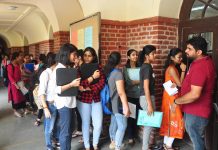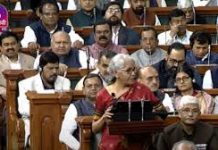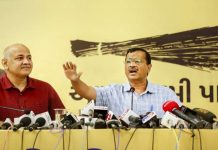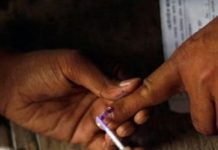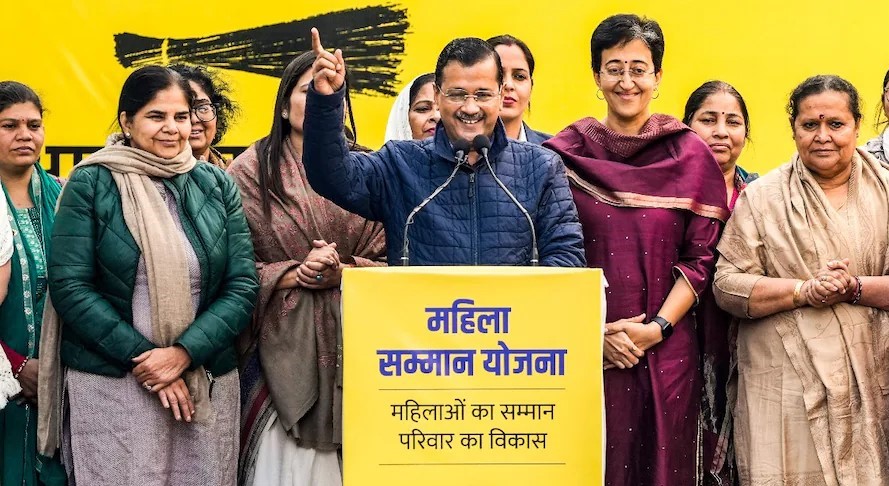
by Yogesh Kant
As Delhi’s political landscape gears up for the 2025 assembly elections, the promises of freebies and guarantees from Aam Aadmi Party (AAP) and Bharatiya Janata Party (BJP) are dominating the narrative. Congress is also trying to regain its position in Delhi political landscape through its style welfare schemes. These parties are vying to outdo each other with generous welfare schemes aimed at capturing voter loyalty. While such promises have become a staple in Delhi’s elections, they come with an undercurrent of economic concern—a significant burden on the city’s budget that could have long-term repercussions for its financial health.
AAP, the incumbent party, has built its political identity on its welfare model. Since coming to power in 2015, the party has introduced and sustained schemes like free electricity for households consuming up to 200 units, benefiting nearly 4.8 million users, free water up to 20,000 liters per month, which reaches around 1.8 million households, free bus rides for women utilized by over 40% of the city’s female commuters, and the much-lauded Mohalla Clinics that have served over 63 million patients since their inception. Ahead of the elections, AAP has also introduced new promises such as the ‘Mukhyamantri Sanjeevani Yojana,’ which provides cashless medical treatment with no upper limit, and a proposed ₹2,100 monthly allowance for women above the age of 18—a scheme that could cost the exchequer over ₹13,000 crore annually if implemented for Delhi’s 6.2 million eligible women.
However, fulfilling these promises is proving to be a herculean task. To fund its election guarantees, the AAP government recently sought a ₹10,000 crore loan from the National Small Savings Fund (NSS). While this move may provide short-term relief, it could also result in major financial consequences due to the heavy interest burden associated with such loans. Experts estimate that repaying this loan, alongside existing subsidies, could strain Delhi’s budget for years, limiting funds for other critical developmental projects.
The subsidy budget of the Delhi government has skyrocketed over the past decade. In 2014-15, the total subsidy allocation stood at ₹1,555 crore. This figure nearly doubled in 2015-16, soaring to ₹3,018 crore, and the revised estimates for 2024-25 project it to reach an unprecedented ₹11,000 crore. Among these, the power sector has seen the most significant increase. From ₹292 crore in 2014-15, power subsidies grew over fivefold to ₹1,443 crore in 2015-16 and are expected to surpass ₹3,600 crore in 2024-25. This subsidy enables private discoms to provide free electricity to consumers using up to 200 units monthly and half-rate for those using up to 400 units. If free electricity is extended to consumers using up to 300 units, as promised by Congress, the subsidy budget could swell by an additional ₹1,000 crore.
Similarly, the water subsidy for the Delhi Jal Board has grown exponentially. From ₹21 crore in 2014-15, it surged to ₹190 crore in 2015-16 and is pegged at ₹500 crore for 2024-25. Under this scheme, consumers using up to 20,000 liters of water monthly receive their supply free of cost. The free travel initiative for women on Delhi Transport Corporation (DTC) and cluster buses has also seen a sharp rise, from ₹115 crore in 2019-20 to an estimated ₹440 crore in 2024-25. Additional allocations include ₹247 crore for students’ uniforms and ₹105 crore for 579 electric buses.
One of the most ambitious promises is the Mukhyamantri Mahila Samman Yojana (MMSY), which proposes a monthly stipend of ₹2,100 for women. If implemented, this scheme could cost over ₹9,500 crore annually. With BJP and Congress also proposing similar or higher allowances, such as ₹2,500 per month, the fiscal burden could escalate to ₹11,400 crore annually. Even at a conservative rate of ₹1,000 per month, the scheme would push Delhi’s projected expenditure for 2025-26 to ₹88,268 crore, against an estimated receipt of ₹80,108 crore, leading to a deficit of ₹8,160 crore. This widening fiscal gap poses a severe challenge for the government’s financial sustainability.
The Mukhyamantri Sanjeevani Yojana, which offers cashless treatment with no upper limit, is another significant commitment. With Delhi’s population exceeding 20 million, the potential number of beneficiaries could overwhelm healthcare resources and inflate costs beyond initial estimates. For instance, if just 5% of the population avails of the scheme annually at an average cost of ₹50,000 per person, the expenditure could surpass ₹5,000 crore.
Political parties are also targeting specific voter groups with tailored promises. The Congress has pledged an ₹8,500 monthly stipend for unemployed youth for a year, while both BJP and Congress have promised subsidized LPG cylinders. Health benefits are another focal point, with proposals for free medical treatment for senior citizens and health insurance schemes worth up to ₹25 lakh. Given that over 500,000 senior citizens reside in Delhi, the financial implications of such promises are significant.
Amid these grand promises, questions about funding sources loom large. Of Delhi’s total budget of ₹88,200 crore for 2024-25, only ₹16,404 crore—less than 20%—is earmarked for capital expenditure on developmental projects. The remaining ₹72,000 crore is allocated for revenue expenditure, covering recurrent costs like salaries, loan repayments, and existing subsidies. This allocation leaves little room for new schemes, making the city increasingly reliant on loans and central grants.
Critics argue that this competitive populism risks undermining Delhi’s long-term fiscal health. The relentless focus on subsidies and freebies diverts resources from critical sectors like infrastructure, healthcare, and education. While AAP has made commendable progress in upgrading government schools and expanding healthcare access through Mohalla Clinics, the quality and reach of secondary and tertiary care facilities remain areas of concern. Similarly, the Municipal Corporation of Delhi (MCD), now under AAP’s control, faces mounting challenges in waste management and urban planning—issues that require significant investment and strategic focus.
The race to promise freebies also raises concerns about equity and efficiency. While welfare schemes provide much-needed relief to vulnerable sections, they often exclude middle-income groups struggling with rising living costs. Moreover, the absence of clear guidelines and accountability mechanisms increases the risk of misuse and inefficiency in implementing these programs.
As Delhi prepares for the 2025 elections, the electorate faces a pivotal choice. While welfare guarantees offer immediate benefits, their long-term implications for the city’s economy and governance cannot be ignored. The voters must weigh the short-term allure of subsidies against the broader need for sustainable development and fiscal responsibility. The outcome of this high-stakes election will not only shape Delhi’s future but also set a precedent for governance models across India.








